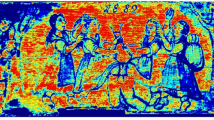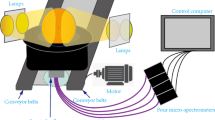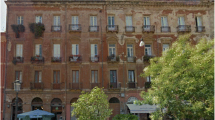Abstract
The presence of soluble salts due to rising damp triggers significant damage to brick masonries, and their distribution needs to be effectively assessed before targeting maintenance intervention. For this purpose, a novel non-invasive approach based on reflectance spectroscopy analysis has been proposed for the preliminary characterisation of soluble salts on masonry surfaces by using a portable spectroradiometer, working in the visible-short wave infrared (Vis-SWIR, 350 ÷ 2500 nm) spectral range. The setup of the technique included the analysis of powdery samples: pure salts, salts mixtures, salts blended with brick powder. Then on field application on a Venetian palace, subjected to rising damp of salty water, was carried out. The results highlight the feasibility of the methodology both in the laboratory and in situ: thanks to instrument portability, low cost, and an adequate possibility to detect salts this technique helps in the planning of the preservation project.
Access this chapter
Tax calculation will be finalised at checkout
Purchases are for personal use only
Similar content being viewed by others
References
Lubelli, B., et al.: Experimental research on hygroscopic behaviour of porous specimens contaminated with salts. Constr. Build. Mater. 18(5), 339–348 (2004)
Snethlage, R., Wendler, E.: Moisture cycles and sandstone degradation. In: Snethlage, R., Baer, N.S. (eds.) Saving our Architectural Heritage: the Conservation of Historic Stone Structures, pp. 7–24. Wiley, Chichester (1997)
Moropoulou, A., et al.: Preservation planning as a tool for a sustainable historic city. WIT Trans. Ecology Environ. 39, 327–336 (2000)
Theoulakis, P., Moropoulou, A.: Salt crystal growth as weathering mechanism of porous stone on historic masonry. J. Porous Mater. 6(4), 345–358 (1999)
Nunes, C., et al.: Study of nitrate contaminated samples from a historic building with the hygroscopic moisture content method: contribution of laboratory data to interpret results practical significance. J. Cult. Herit. 30, 57–69 (2018)
Giovannacci, D., et al.: Non intrusive tools to detect salts contamination in masonry: case study of fontaine-chaalis church. In: Optics for Arts, Architecture, and Archaeology VI, vol. 10331, p. 1033103. International Society for Optics and Photonics (2017)
Avdelidis, N.P., Moropoulou, A.: Applications of infrared thermography for the investigation of historic structures. J. Cult. Herit. 5(1), 119–127 (2004)
EN 16682:2017. Conservation of cultural heritage - Methods of measurement of moisture content, or water content, in materials constituting immovable cultural heritage. CEN, Comité européen de normalisation Norme européenne (2017)
Nasraoui, M., Nowik, W., Lubelli, B.: A comparative study of hygroscopic moisture content, electrical conductivity and ion chromatography for salt assessment in plasters of historical buildings. Const. Build. Mater. 23(5), 1731–1735 (2009)
Cipra, J.E., et al.: Measuring radiance characteristics of soil with a field spectroradiometer. Soil Sci. Soc. Am. J. 35(6), 1014–1017 (1971)
Stenberg, B., et al.: Visible and near infrared spectroscopy in soil science. In: Sparks, D.L. (ed.) Advances in Agronomy, vol. 107, pp. 163–215. Academic Press, Burlington (2010)
Fang, Q., et al.: Visible and near-infrared reflectance spectroscopy for investigating soil mineralogy: A review. J. Spectr. 2018, 1–14 (2018)
Farifteh, J., et al.: Spectral characteristics of salt-affected soils: a laboratory experiment. Geoderma 145(3–4), 196–206 (2008)
Edwards, B.L., et al.: Simple infrared techniques for measuring beach surface moisture. Earth Surf. Proc. Land. 38(2), 192–197 (2013)
Ma, C., et al.: Analysis of the effects of salt content on soil spectral characteristics. In: Proceedings of the 3rd International Conference on Agro-Geoinformatics, pp. 1–6. IEEE (2014)
Monnard, A., et al.: Influence of moisture content on colour of granular materials. Part I: experiments on yellow ochre. Granular Matter 18(3), 47 (2016)
Bacci, M., et al.: Non-invasive spectroscopic measurements on the Il ritratto della figliastra by Giovanni Fattori: identification of pigments and colourimetric analysis. J. Cult. Herit. 4(4), 329–336 (2003)
Camaiti, M., et al.: Hyperspectral sensor for gypsum detection on monumental buildings. J. Geophys. Eng. 8(3), S126–S131 (2011)
Suzuki, A., et al.: Laboratory study of the sulfation of carbonate stones through SWIR hyperspectral investigation. J. Cult. Herit. 32, 30–37 (2018)
Benvenuti, M., et al.: A portable hyper spectral device for monitoring the chemical and mineralogical composition of historical buildings surfaces. In: Ferrari, A. (ed.) 4th International Congress on Science and Technology for the Safeguard of Cultural Heritage in the Mediterranean Basin, pp. 167–168. Il Cairo, Egypt (2009)
Falchi, L., et al.: Rising damp in historical buildings: a venetian perspective. Build. Environ. 131, 117–127 (2018)
Alparone, L., et al.: Hyperspectral instruments as potential tools for monitoring decay processes of historical building surfaces. In: Fioravanti, M., Mecca, S. (eds.) The Safeguard of Cultural Heritage: A Challenge From the Past for the Europe of Tomorrow, pp. 192–194. Firenze University Press, Firenze (2011)
Bacci, M.: Fibre optics applications to works of art. Sens. Actuators B Chem. 29(1–3), 190–196 (1995)
Balas, C., et al.: A novel hyper-spectral imaging apparatus for the non-destructive analysis of objects of artistic and historic value. J. Cult. Herit. 4, 330–337 (2003)
Camaiti, M., et al.: Monitoring of chemical and physical characteristics of stone surfaces by a portable spectroradiometer. Geophys. Res. Abstr. 15, 13552 (2013)
Campbell, J.B., Wynne, R.H.: Introduction to Remote Sensing. Guilford Press, New York (2011)
Clark, R.N., et al.: High spectral resolution reflectance spectroscopy of minerals. J. Geophys. Res. Solid Earth 95(B8), 12653–12680 (1990)
Clark, R.N.: Spectroscopy of rocks and minerals, and principles of spectroscopy. Manual Remote Sens. 3(3–58), 2–2 (1999)
Biscontin, G., et al.: Indagine sui fenomeni di risalita capillare nelle murature di Venezia. In: Il mattone di Venezia. Contributi presentati al concorso di idee su patologia, diagnosi e terapia del mattone di Venezia, pp. 33–65
Fassina, V., et al.: Evaluation of compatibility and durability of a hydraulic lime-based plaster applied on brick wall masonry of historical buildings affected by rising damp phenomena. J. Cult. Herit. 3(1), 45–51 (2002)
Corradini M.: Investigation of the rising damp phenomenon in historical Venetian buildings by a new multianalytical approach. Ms thesis, Ca’ Foscari University of Venice (2020)
Steiger, M., et al.: Hydration of MgSO4·H2O and generation of stress in porous materials. Cryst. Growth Des. 8(1), 336–343 (2008)
Yang, P., et al.: Hygroscopicity measurement of sodium carbonate, β-alanine and internally mixed β-alanine/Na2CO3 particles by ATR-FTIR. J. Environ. Sci. 87, 250–259 (2020)
Sælensminde, J., Samarakoon, S.S.M.: Deterioration of concrete structures due to salt crystallization; influence of salt types and relative humidity. In: Hansen, K.K., Rode, C., Nilsson, L-O. (eds.) Proceedings on International RILEM Conference on Materials, Systems and Structures in Civil Engineering Conference segment on Moisture in Materials and Structures, pp. 120–127. RILEM Publications SARL (2016)
Tian, Y., et al.: Raman spectroscopy of sodium chloride under high-pressure and high-temperature. arXiv preprint arXiv:1903.11824 (2019)
Author information
Authors and Affiliations
Corresponding authors
Editor information
Editors and Affiliations
Ethics declarations
Scientific activity performed with the contribution of the Provveditorato for the Public Works of Veneto, Trentino Alto Adige and Friuli Venezia Giulia, provided through the concessionary of State Consorzio Venezia Nuova and coordinated by CORILA. The research was promoted thanks also to the interest and support of the Patto per lo Sviluppo della Città di Venezia (Comune di Venezia).
Rights and permissions
Copyright information
© 2022 The Author(s), under exclusive license to Springer Nature Switzerland AG
About this paper
Cite this paper
Cimino, D., Falchi, L., Corradini, M., Lucero Gomez, P., Balliana, E., Zendri, E. (2022). Reflectance Spectroscopy as a Non-invasive Technique for Preliminary Characterization of Soluble Salts on Historical Masonries. In: Osman, A., Moropoulou, A. (eds) Advanced Nondestructive and Structural Techniques for Diagnosis, Redesign and Health Monitoring for the Preservation of Cultural Heritage. Springer Proceedings in Materials, vol 16. Springer, Cham. https://doi.org/10.1007/978-3-031-03795-5_4
Download citation
DOI: https://doi.org/10.1007/978-3-031-03795-5_4
Published:
Publisher Name: Springer, Cham
Print ISBN: 978-3-031-03794-8
Online ISBN: 978-3-031-03795-5
eBook Packages: Chemistry and Materials ScienceChemistry and Material Science (R0)




